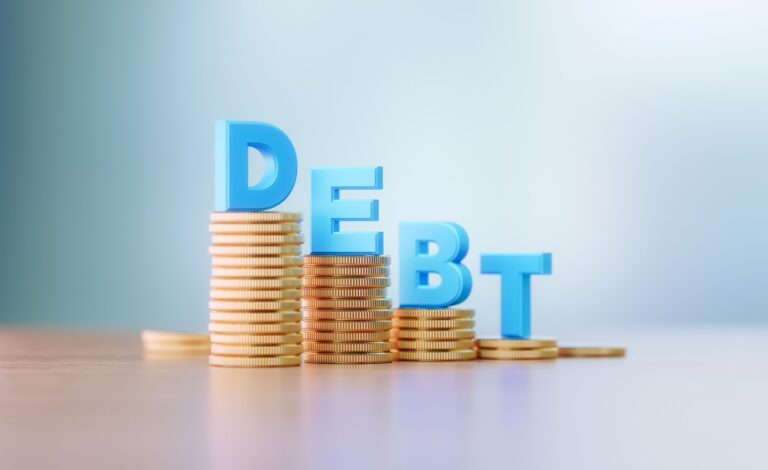On this page
What's next
Earn a high-yield savings rate with JG Wentworth Debt Relief
The 3 Biggest Strategies for Paying Down Debt in 2025
by
JG Wentworth
•
September 29, 2025
•
8 min

This information is provided for educational and informational purposes only. Such information or materials do not constitute and are not intended to provide legal, accounting, or tax advice and should not be relied on in that respect. We suggest that You consult an attorney, accountant, and/or financial advisor to answer any financial or legal questions.
As Americans entered 2025, debt reduction emerged as the top financial priority for millions of households across the country – 89%, to be exact. But as of September of the same year, it doesn’t look like that goal is being met as our national debt is $37 Trillion… and growing.
With consumer debt levels remaining elevated and interest rates continuing to impact borrowing costs, finding effective strategies to eliminate debt has become more crucial than ever. Based on current financial expert recommendations and industry practices, three primary strategies have risen to prominence as the most effective approaches for paying down debt in 2025 and beyond…
Strategy 1: The Debt Avalanche vs. Debt Snowball Methods
The foundation of most successful debt reduction plans centers around two mathematically-driven approaches that help borrowers systematically eliminate their obligations.
The Debt Avalanche Method
The debt avalanche method focuses on paying off debts with the highest interest rates first while maintaining minimum payments on all other debts. This strategy is mathematically optimal because it minimizes the total amount of interest paid over time. For borrowers with multiple high-interest credit cards, personal loans, or other consumer debt, this approach can result in significant savings.
The process involves:
- Listing all debts from highest to lowest interest rate.
- Directing any extra payment capacity toward the highest-rate debt until it’s eliminated.
- Once the highest-rate debt is paid off, the payment amount previously allocated to that debt is redirected to the next-highest rate debt, creating an “avalanche” effect.
The Debt Snowball Method
In contrast, the debt snowball method prioritizes paying off the smallest debt balances first, regardless of interest rate. This psychological approach leverages the motivational power of quick wins to build momentum in debt elimination efforts. Research has shown that the emotional satisfaction of completely eliminating debts can help borrowers maintain their debt reduction efforts over the long term.
With the snowball method:
- Borrowers list their debts from smallest to largest balance and focus extra payments on the smallest debt while maintaining minimums on others.
- Once the smallest debt is eliminated, its payment amount rolls into the next smallest debt, creating a “snowball” effect that grows larger as debts are eliminated.
Choosing between methods
Financial experts recommend the avalanche method for borrowers who are motivated by mathematical optimization and can maintain discipline without frequent psychological reinforcement. The snowball method works better for those who need regular motivation through visible progress and debt elimination milestones.
Take your next step towards being debt-free
"*" indicates required fields
Strategy 2: Debt consolidation
Debt consolidation has become increasingly sophisticated in 2025, with personal loans emerging as one of the most effective tools for simplifying and reducing debt burdens. This strategy involves taking out a single loan to pay off multiple existing debts, ideally at a lower interest rate than the average of the original debts.
How consolidation works
Personal loans for debt consolidation typically offer fixed interest rates and fixed monthly payments over terms ranging from two to seven years. Borrowers with good to excellent credit can often qualify for rates significantly lower than credit card interest rates, which can result in substantial savings over time.
The consolidation process involves:
- Applying for a personal loan amount equal to the total of existing debts.
- Using the loan proceeds to pay off all existing balances.
- Making a single monthly payment on the new loan.
This approach transforms multiple payment due dates, interest rates, and minimum payments into one streamlined obligation.
Benefits of consolidation
Personal loan consolidation offers several advantages over other debt management approaches:
- Fixed interest rates provide predictability in monthly payments, making budgeting easier.
- Fixed payment schedules create a clear timeline for debt elimination, unlike minimum credit card payments that can extend repayment indefinitely.
- Additionally, personal loans often feature lower interest rates than credit cards, especially for borrowers with good credit scores.
- The single monthly payment eliminates the complexity of managing multiple creditors and due dates, reducing the risk of missed payments.
Qualifying for consolidation loans
Lenders typically evaluate applicants based on credit score, income stability, debt-to-income ratio, and employment history. Borrowers with credit scores above 650 generally have access to the most competitive rates, while those with scores below 600 may face higher rates or require secured loan options.
Strategy 3: Strategic balance transfers with 0% APR credit cards
Balance transfer credit cards have evolved into sophisticated debt management tools, particularly with the availability of extended 0% APR promotional periods that can last 12 to 24 months. This strategy allows borrowers to move high-interest debt to a card with no interest charges during the promotional period.
How balance transfers work
- Balance transfer cards allow borrowers to move existing credit card balances from high-interest cards to a new card offering a promotional 0% APR period.
- During this promotional period, typically ranging from 12 to 21 months, no interest accrues on the transferred balance, allowing all payments to go directly toward principal reduction.
- Most balance transfer cards charge a one-time transfer fee, usually 3% to 5% of the transferred amount (however, this upfront cost is often far less than the interest that would accumulate on high-rate cards over the same period).
Maximizing balance transfer benefits
Success with balance transfers requires discipline and strategic planning:
- Borrowers must commit to paying off the entire transferred balance before the promotional rate expires, as post-promotional rates are often comparable to or higher than original card rates.
- The most effective approach involves calculating the monthly payment needed to eliminate the balance during the promotional period, then consistently making that payment amount.
- For example, a $12,000 balance transferred to a card with 18 months at 0% APR would require monthly payments of approximately $667 to eliminate the debt before interest begins accruing.
Balance transfer considerations
Balance transfers work best for borrowers who can qualify for cards with extended promotional periods and who have the discipline to avoid accumulating new debt on paid-off cards. The strategy is most effective for credit card debt specifically, as personal loans, mortgages, and most other debt types cannot be transferred to credit cards.
Borrowers must also consider their credit utilization ratio, as balance transfers can temporarily increase utilization on the new card. However, paying down the transferred balance quickly can improve credit scores by reducing overall credit utilization.
Implementation considerations
Regardless of which debt strategy is best for you, keep the following in mind:
- Create a comprehensive debt elimination plan: Successful debt reduction requires more than selecting a strategy; it demands a comprehensive approach that addresses spending habits, budget management, and financial behavior modification. The most effective debt elimination plans begin with a complete inventory of all debts, including balances, interest rates, minimum payments, and due dates.
- Avoid common pitfalls: Many debt reduction efforts fail due to predictable mistakes. Taking on new debt while paying off existing obligations undermines progress and can trap borrowers in cycles of debt accumulation. Similarly, choosing consolidation or balance transfer options without addressing underlying spending habits often results in accumulated debt on both old and new accounts.
- Build emergency funds during debt reduction: While aggressive debt paydown is important, financial experts recommend maintaining at least a small emergency fund even while carrying debt. This prevents new debt accumulation when unexpected expenses arise and helps maintain progress toward debt elimination goals.
The bottom line
The three primary strategies for debt elimination in 2025 – systematic payment methods (avalanche/snowball), debt consolidation, and strategic balance transfers – each offer distinct advantages depending on individual financial circumstances, credit profiles, and psychological preferences.
The key to success lies not just in selecting the right strategy, but in implementing it consistently while addressing the underlying financial behaviors that created the debt situation. Borrowers who combine these tactical approaches with comprehensive budget management, spending discipline, and emergency fund building position themselves for both immediate debt reduction success and long-term financial stability.
There’s always JG Wentworth…
Do you have $10,000 or more in unsecured debt? If so, there’s a good chance you’ll qualify for the JG Wentworth Debt Relief Program.* Some of our program perks include:
- One monthly program payment
- We negotiate on your behalf
- Average debt resolution in as little as 48-60 months
- We only get paid when we settle your debt
If you think you qualify for our program, give us a call today so we can go over the best options for your specific financial needs. Why go it alone when you can have a dedicated team on your side?
SOURCES CITED
Konish, L., “Paying down debt is Americans’ top financial goal for 2025.” CNBC. December 18, 2024.
GovFacts. “US National Debt: $37 Trillion and Growing.” September 7, 2025.
Kamel, G., “How the Debt Snowball Method Works.” Ramsey. August 19, 2025.
About the author
Recommended reading for you
* Program length varies depending on individual situation. Programs are between 24 and 60 months in length. Clients who are able to stay with the program and get all their debt settled realize approximate savings of 43% before our 25% program fee. This is a Debt resolution program provided by JGW Debt Settlement, LLC (“JGW” of “Us”)). JGW offers this program in the following states: AL, AK, AZ, AR, CA, CO, FL, ID, IN, IA, KY, LA, MD, MA, MI, MS, MO, MT, NE, NM, NV, NY, NC, OK, PA, SD, TN, TX, UT, VA, DC, and WI. If a consumer residing in CT, GA, HI, IL, KS, ME, NH, NJ, OH, RI, SC and VT contacts Us we may connect them with a law firm that provides debt resolution services in their state. JGW is licensed/registered to provide debt resolution services in states where licensing/registration is required.
Debt resolution program results will vary by individual situation. As such, debt resolution services are not appropriate for everyone. Not all debts are eligible for enrollment. Not all individuals who enroll complete our program for various reasons, including their ability to save sufficient funds. Savings resulting from successful negotiations may result in tax consequences, please consult with a tax professional regarding these consequences. The use of the debt settlement services and the failure to make payments to creditors: (1) Will likely adversely affect your creditworthiness (credit rating/credit score) and make it harder to obtain credit; (2) May result in your being subject to collections or being sued by creditors or debt collectors; and (3) May increase the amount of money you owe due to the accrual of fees and interest by creditors or debt collectors. Failure to pay your monthly bills in a timely manner will result in increased balances and will harm your credit rating. Not all creditors will agree to reduce principal balance, and they may pursue collection, including lawsuits. JGW’s fees are calculated based on a percentage of the debt enrolled in the program. Read and understand the program agreement prior to enrollment.
This information is provided for educational and informational purposes only. Such information or materials do not constitute and are not intended to provide legal, accounting, or tax advice and should not be relied on in that respect. We suggest that you consult an attorney, accountant, and/or financial advisor to answer any financial or legal questions.






